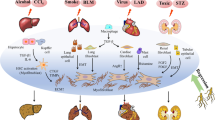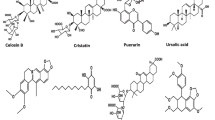Abstrac
In this review, the researches on Chinese herb components with anti-hepatic fibrosis activity in China in the recent 20 years were generalized. Almost thirty active herb components attracted author’s attention, especially, salvianolic acid B and oxymatrine which were investigated comprehensively. Moreover, the author considered that, in view of the complex pathogenesis and the multi-pathway and multi-target superiority of Chinese medicine formula, the effective components formula investigations deserve more attention and probably prompt a potential researching direction.
Similar content being viewed by others
References
Li XM, Li HS, Hu YY. Research progress of anti-liver fibrosis herbal ingredients or constituents. Chin J Integr Tradit West Med Liver Dis (Chin) 2008;18:186–189.
Liu P, Hu YY, Liu C, Zhu DY, Xue HM, Xu ZQ, et al. Clinical observation of salvianolic acid B in treatment of liver fibrosis in chronic hepatitis B. World J Gastroenterol 2002;8:679–685.
Hu YY, Liu P, Liu C, Gu HT, Xu LM, Liu CH, et al. Influence of the extract of Radix Salviae Miltiorrhizae on hepatic fibrosis induced by CCl4 and DMN in rats. Shanghai J Tradit Chin Med (Chin) 1999;33:7–10.
Liu CH, Liu P, Hu YY, Zhu DY. Effects of salvianolic acid-B on TGF-β1 stimulated hepatic stellate cell activation and its intracellular signaling. Natl Med J China (Chin) 2002;82:1267–1272.
Tao YY, Wang XL, Liu CH. Salvianolic acid-B effects on TGF-β1/ERK signaling transduction in NIH/3T3 fibroblast. J Capit Med Univ (Chin) 2007;28:192–195.
Mao YM, Zeng MD, Lu LG, Li JQ, Wan MB, Li CZ, et al. Oxymatrine capsule in the treatment of liver fibrosis in patients with chronic virus hepatitis: a randomized, double blind, placebo-controlled, multicenter clinical study (II). Chin Hepatol (Chin) 2002;4:222–225.
Zen WZ, Wu XL, Jiang MD. Effect of oxymarine on Smad gene expression in CCl4-induced hepatic fibrosis in rats. World J Dig (Chin) 2005;13:984–987.
Song J, Wang LL, Zhu L, Zhong HM, Yao P. Effects of oxymatrine on procollagen III metabolism and its gene expression in experimental fibrotic rats. Chin J Hepatol (Chin) 2003;11:697.
Lu Q, Zhang QB, Zhang JM, Yin YK, Wu XH. The inhibition effect of oxymatrine on the activation of paracrine pathway of hepatic stellate cells. Chin Hepatol (Chin) 2004;9:31–33.
Author information
Authors and Affiliations
Rights and permissions
About this article
Cite this article
Hu, Yy. Pay attention to the study on active antiliver fibrosis components of Chinese herbal medicine. Chin. J. Integr. Med. 18, 563–564 (2012). https://doi.org/10.1007/s11655-012-1029-7
Received:
Published:
Issue Date:
DOI: https://doi.org/10.1007/s11655-012-1029-7




